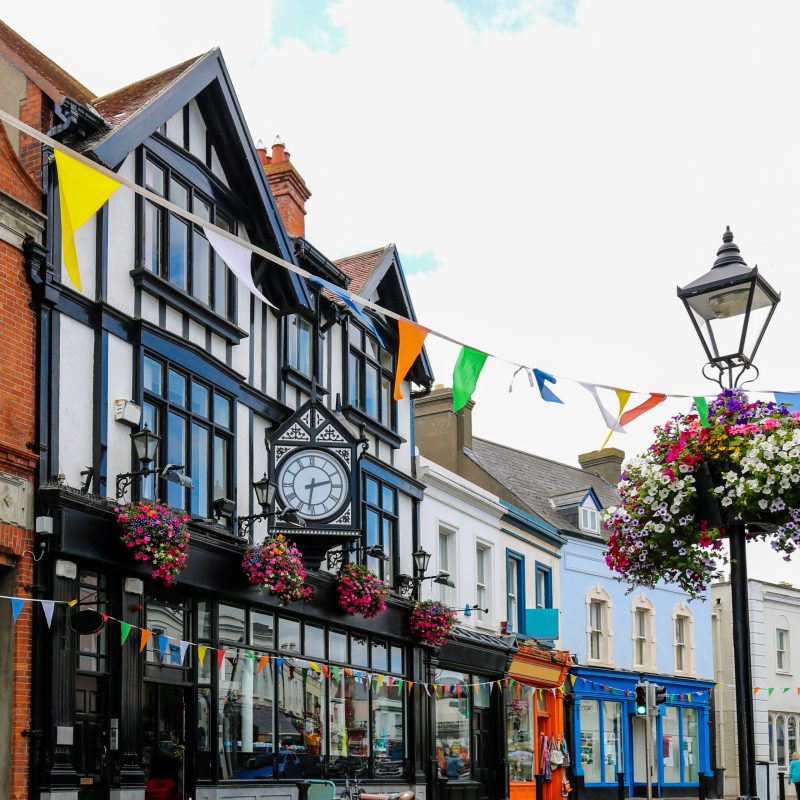
Dalkey, Ireland, is a picturesque seaside resort southeast of Dublin that originally developed as a Viking settlement. Today, it has become a favorite for residents and tourists who seek history, great food, atmosphere, long walks in town and along the coastline, and modern-day events of cultural celebrations.
Videos by TravelAwaits
The ancient Irish name Deilg Inis means “Thorn Island,” but it was eventually anglicized to the modern “Dalkey.” Used as a stronghold by both the Vikings and the Anglo-Normans, this village attracts tourists as a literary hub for popular hometown author Maeve Binchy and summertime resident George Bernard Shaw. Dalkey keeps tourists coming back with its lovely restaurants, pubs, and charming Coliemore Harbour.
Today, tiny cottages that once held workers for the harbor and town now sell for €1 million for “two beds and a bit of land.” But that exclusivity does lend to the peace and safety of the village. Just mind when you cross the road… “the drivers think they have the right of way,” our guide tells us, and the streets are narrow.

1. Dalkey Castle & Heritage Center
Dalkey Castle and Heritage Center introduces visitors to Dalkey Castle’s rich and varied history. In the 1390s, seven castles were built as storehouses — fortified against intruders with things like machicolation and murder holds — to protect goods until they could be sent north overland to Dublin. Castle #4, across the street, remains in ruins but is sturdy enough for Halloween shenanigans and to be an excellent backdrop for festivals.
You can spend hours in the visitor center reviewing the expertly assembled historical data organized in interactive displays, a film, and the replica doorway that shows different fortifications that prevented unwanted visitors.
On the tour, you’ll enjoy a movie explaining the area and history, explore the storeroom on the ground floor, pass the mezzanine used for storage, and enjoy live re-enactments in the main living room and garderobe upstairs (with indoor plumbing!) as well as the graveyard, church, and castle rooftop.
But for a great time, be sure to visit with the tour guides, a treasure trove of information and long-time residents who have known the authors and actors that have lived in the area. They’ll help point out the placards for all of the original seven castles.

Saint Begnet’s Church
Both ancient Dalkey churches are dedicated to Saint Begnet.
Saint Begnet’s Church and Graveyard, within the Dalkey Castle & Heritage Center property, was originally a wooden structure with a thatched roof built in the 700s. On the east side, you’ll find a Tau cross, a design used by Saint Francis from 1312 to describe the trinity and later to become part of the Franciscan Crest. The current stone church, built in the 10th century, included large beams and woven tapestry. The north-facing arrow loop window is wide from the inside allowing a protective archer to maneuver, but the outside is quite narrow to prevent arrows or intruders from entering.
The double bell tower was unusual in those times and required staff to climb to reach the bells. The Chancel and Chancel Arch were added in the 13th century. Through the chancel window, you can see the large yew tree, perfect not only for making arrows and firewood for ashes for Ash Wednesday, but also to keep animals from disturbing the cemetery. The berries are poisonous.
The northern door is quite small, but it wasn’t always this way. The graveyard has been in use since the 1300s but was not recorded until 1738. The last legal burial was Mrs. Ann Kavanaugh in 1930. More than 2,000 people have been buried here, and since space was needed, the ground has risen over the years. So the door isn’t short, the ground is high.

2. Coliemore Harbour
Caladh Mor, Or ‘Big Harbour’
After the Anglo-Norman arrival in 1169, the new political and social order required safe harbors, and in 1244, a royal order was issued promoting Dalkey to harbor. Large ships could anchor safely and unload their cargo in the deep sheltered waters of Dalkey Sound. It was the primary port for Dublin until the River Liffey was dredged around 1590.
In 1807, the Prince of Wales and the Rochdale — two troop ships on their way to battle Napoleon — sank in gale-force winds and heavy snow, losing 380 troops and their families traveling with them. This led to the building of the Dun Laoghaire Harbour and the beginning of a new life for the Dalkey Quarry.
Its success led to the construction of Coliemore Harbor in 1868 by a local builder named John Cunningham.
Today, walk along the harbor and enjoy watching the kids jump 15 or so feet into the water. You’ll find transport to Dalkey Island and a spacious overlook with benches to enjoy your lunch.
3. Festivals
Books, Literary And Fan Fiction, Lobsters, And Writers
A bonanza of festivals is held each year, frequently organized through the Dalkey Visitor Center. In June, the Dalkey Book Festival hosts The Bloomsday Event on the 16th, which heralds dramatizations from James Joyce’s Ulysses, A Portrait of the Artist as a Young Man, and Dubliners. A Guided Joycean Walk of Dalkey follows the performance. Joyce had many connections to the area and stayed at the Sandycove Martello Tower as a guest of fellow writer Oliver St. John Gogarty.
Both Heritage Week and the much-awaited Lobster Festival take place in August. The Maeve Binchy and Irish Writers Festivals are at the end of September. Although Maeve died in 2012, she was a beloved neighbor, and her husband, Gordon, remains here today.

4. Literary Walking Tours
Maeve Binchy And George Bernard Shaw
The Dalkey Heritage Center offers walking tours reflecting Binchy’s and Shaw’s connections to Dalkey. For Maeve Binchy, one story was shared about the Church as she grew ill. She hadn’t been a regular churchgoer but asked the priest if he’d say her funeral mass at the Church of the Assumption. He assured her she was always welcome, regardless of circumstance.

George Bernard Shaw and Bob Dylan were the only two people to win both an Academy Award and Nobel Prize. Shaw’s childhood home on Dalkey Hill, Torca Cottage, overlooks Killiney Bay from Sorrento Terrace to Greystones, of which he said:
“I lived on a hilltop with the most beautiful view in the world — I had only to open my eyes to see such pictures as no painter could make for me.”
Torca College went on the market in 2016 for €2.45 million.
5. Dalkey Island And Martello Tower
In 1348, the bubonic plague, the “Black Death” arrived, and people fled Dublin for the safety of Dalkey Island.
Today, just a 5-minute boat ride from Coliemore Harbour, the island visit includes the ruins of St. Begnet’s Church — not to be confused with the church at the Dalkey Castle — and a Martello Tower from 1804. Arrowheads and other ancient artifacts continue to be found on the island.
Prior to 1798, one Dalkey Island festival in June elected a “King of Dalkey and Emperor of The Muglins.” The Muglins are the rocks to the east of the island, dangerous to shipping channels and fitted with a distinctive beacon, The Muglins Lighthouse, where pirates Peter McKinlie and George Gidley were placed on display following their execution for murdering the Captain aboard the ship The Earl of Sandwich in 1765.

6. Dublin Coastal Walk
Dublin’s coastal walk stretches from above Skerries to Greystone and south of Bray. The walk from Dalkey to Killiney is one of the most popular.
You can walk from Sorrento Park or south from Coliemore Harbour, enjoying the views of the Irish Sea, Dalkey Island, and The Muglins.

Best Restaurants
The Dalkey Castle staff recommends Ouzos Steak and Seafood, where you can dine inside, or if you’re in a hurry to sit seaside, order takeaway. With so many options on the menu, our family dined on fish and chips, a shrimp and scallop fettuccine dish, and a curry dish, followed by apple crumble. Delicious!

You’ll pass Finnegan’s of Dalkey, a favorite pub for watching the game or catching up with friends for a pint on the way from the train station to the town center. Stop for pub fare and offer to buy a local a pint and prepare to be regaled with tales of the town.
The Corner Note Café in the middle of town is a nice place to sit outside, enjoy your meal, and people-watch.
The Club, found on the way to Coliemore Harbour, is the place to sit and watch harbor life go by. It’s peaceful and a great place to eat.
Of course, stopping at the local shops for groceries or paella makes for an excellent takeaway meal to eat harborside.
There’s something for everyone in Dalkey.
